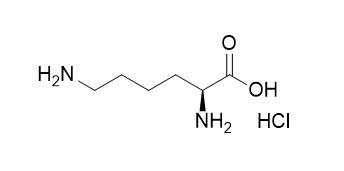L-(+)-Lysine monohydrochloride
L-lysine monohydrochloride (LMH) could as a chloruretic acidifying adjuvant to mercurial diuretics. LMH might participate in the regulation of B cells of pancreatic islet and thus the decrease of blood sugar level in the spinal cord injured rats. LMH has an immunomodulatory effects.
Inquire / Order:
manager@chemfaces.com
Technical Inquiries:
service@chemfaces.com
Tel:
+86-27-84237783
Fax:
+86-27-84254680
Address:
1 Building, No. 83, CheCheng Rd., Wuhan Economic and Technological Development Zone, Wuhan, Hubei 430056, PRC
Providing storage is as stated on the product vial and the vial is kept tightly sealed, the product can be stored for up to
24 months(2-8C).
Wherever possible, you should prepare and use solutions on the same day. However, if you need to make up stock solutions in advance, we recommend that you store the solution as aliquots in tightly sealed vials at -20C. Generally, these will be useable for up to two weeks. Before use, and prior to opening the vial we recommend that you allow your product to equilibrate to room temperature for at least 1 hour.
Need more advice on solubility, usage and handling? Please email to: service@chemfaces.com
The packaging of the product may have turned upside down during transportation, resulting in the natural compounds adhering to the neck or cap of the vial. take the vial out of its packaging and gently shake to let the compounds fall to the bottom of the vial. for liquid products, centrifuge at 200-500 RPM to gather the liquid at the bottom of the vial. try to avoid loss or contamination during handling.
Cell Signal.2022, 99:110433.
J Cell Physiol.2020, 10.1002
Separations2023, 10(4),255.
Nutrients.2021, 13(1):254.
South African J of Plant&Soil2018, 29-32
Genes Environ.2024, 46(1):13.
LWT-Food Sci Technol2020, 109163
Foods.2024, 13(11):1739.
Nutr Cancer.2023, 75(1):376-387.
J Ethnopharmacol.2019, 241:112025
Related and Featured Products
Life ences, 1999, 65(2):PL19.
Neuroprotective effect of L-lysine monohydrochloride on acute iterative anoxia in rats with quantitative analysis of electrocorticogram.[Reference:
WebLink]
Lysine is one of the indispensible amino acids and L-lysine monohydrochloride (L-(+)-Lysine monohydrochloride,LMH) is widely available to public as a nonprescription oral supplement. Potential clinical usefulness of oral LMH supplements has been indicated in stroke, hypertension, and seizure induced by pentylenetetrazole (PTZ), etc.
METHODS AND RESULTS:
We compared the effects of LMH and flunarizine on the Electrocorticogram (EcoG) of rats intragastrically administered 1 hour before anoxia. LMH dose-dependently prolonged the time reaching the lowest ECoG average amplitude after anoxia and decreased the recovery time after recirculation in both 0.63 g/kg and 1.26 g/kg groups. There was significant difference between the LMH- and saline-pretreated groups but no significant difference between the 1.26 g/kg LMH- and 2.5 mg/kg flunarizine-pretreated groups. The difference was not significant in the 2.52 g/kg group. The ECoG average amplitude did not reach isoelectric point and the lowest average amplitude was 10 percent of that of nomoxia in the 1.26 g/kg LMH-pretreated group during 2-min anoxia. The average amplitude pretreated with LMH (0.63 and 1.26 g/kg) was lower than that of those pretreated with saline and flunarizine.
CONCLUSIONS:
The results tend to indicate that LMH can protect brain cells against anoxia by means of providing energy, reducing cerebral metabolic rate and inhibiting the effect of the excitable amino acids.
Journal of Medical Virology 1989, 16-20
Effect of l‐lysine monohydrochloride on cutaneous herpes simplex virus in the guinea pig.[Reference:
WebLink]
METHODS AND RESULTS:
The effect of topical applications of crystalline lysine(L-(+)-Lysine monohydrochloride ) therapy on cutaneous herpes simplex virus (HSV) inoculations and subsequent dorsal root ganglia (DRG) infection was studied in male Hartley guinea pigs. Although HSV‐I was recovered from the inoculated sites from all animals, the L‐lysine‐treated skin remained clinically normal, whereas untreated controls manifested clinical symptoms up to 3 days postinoculation (p.i.). However, cocultivation of DRG (C1‐S1) indicated a selective tropism of infective particles to specific DRG in the groups treated with amino acids. In lysine‐treated animals, HSV was recovered from a few DRG (T‐12, T‐13, and L‐1) at 3 days p.i. and from DRG T‐10 in leucine‐treated controls; yet no HSV was recovered from DRG of untreated controls.
CONCLUSIONS:
These results suggest an immunomodulatory effect of L‐lysine on inoculation site infections and the possible potentiation of subsequent DRG manifestation in amino‐acidtreated animals.
Chinese Journal of Neuroimmunology and Neurology, 2010.
Effect of L-lysine monohydrochloride on pancreatic islet and blood sugar levels in the spinal cord injured rats.[Reference:
WebLink]
To observe the effect of L-lysine monohydrochloride (L-(+)-Lysine monohydrochloride,LMH) on pancreatic islet B cells, the levels of endogenous insulin and blood sugar levels in the injured spinal cord of rats.
METHODS AND RESULTS:
The rats were randomly divided into four groups, the healthy control group, the spinal cord injury group, the LMH1 group and the LMH2 group.The rat model was produced by hemi-transection at the lower right thoracic spinal cord aseptically.Peritoneal injection of LMH was adopted among the rats in the LMH1 group and the LMH2 group at 621.5, 310.8 mg/kg respectively for once.Equivalent normal saline was injected into the rats of the spinal cord injury group. The immunohistochemical reactions of positive B cells were significantly weaker in the spinal cord injured group than in the control group (P0.01).The levels of endogenous insulin were significantly lower and the blood sugar levels were significantly higher in the spinal cord injured group than in the control group (P0.01).The immunohistochemical reactions of positive B cells were significantly stronger in LMH group than in the spinal cord injured group (P0.05) ; the levels of endogenous insulin were significantly higher and the blood sugar levels were significantly lower in LMH1 group (621.5 mg/kg) than in the spinal cord injured group (P0.05).The immunohistochemical reaction of positive B cells, the levels of endogenous insulin and the blood sugar levels had no significant difference in LMH2 group (310.8 mg/kg) compared with that in the spinal cord injured control group (P0.05).
CONCLUSIONS:
The results indicate that LMH might participate in the regulation of B cells of pancreatic islet and thus the decrease of blood sugar level in the spinal cord injured rats.



